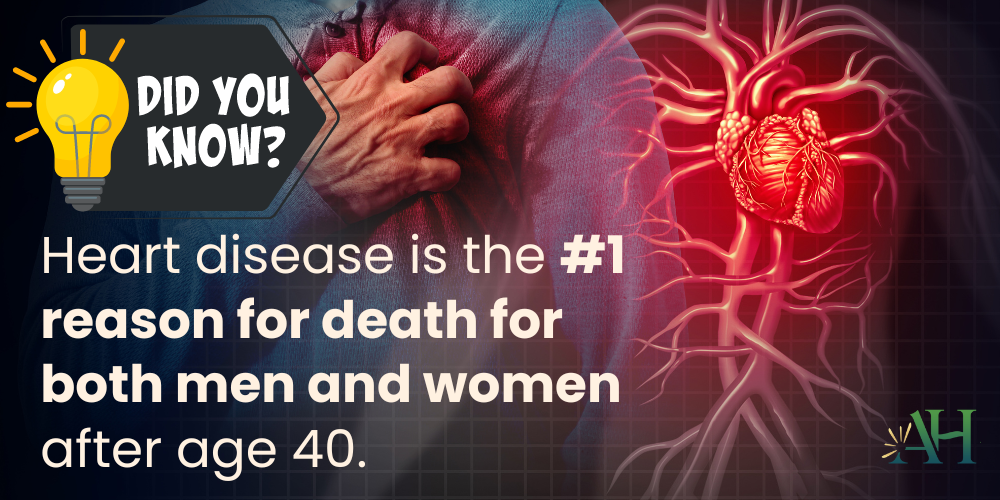Hello and (a belated) welcome to 2024!
I apologize for the delay in these emails/blog posts — we’ve had a lot of transition at our clinic and needed to devote time to making sure it went as smoothly as possible. Now that we are on the other side and the dust is settling, it’s time to get back into writing!
Today’s topic is going to be the start of a blog series on heart disease. I have wanted to do an in-depth review of heart disease from the perspective of primary care for a really long time; however, this is such a broad topic that I previously shied away from doing it. It is a topic with some surprisingly big controversial areas, and I needed some time to think through these myself. But here we are — February is Heart Health Month, and I’m now pumped to share what I know! I hope you enjoy the series.

Why Should I Care About Heart Disease?
- Based on 2021 CDC data, heart attacks account for the #1 reason for death in America by far. Almost 700,000 people die from heart disease each year. If you add in strokes (which you should, it’s a heart attack of the brain), the number climbs to 860,000 cases each year. Cancer account for 600,000 cases.
- Heart disease is the number one reason for death for both men and women after age 40. It’s riskier than cancer, COVID, diabetes, car wrecks, etc.
- Heart disease is a problem of time. The heart attack or stroke is a culmination of 20-30+ years of disease developing under the radar. The earlier you intervene, the better your heart future looks!
- Prevention works! Most risk factors are completely preventable/reversible conditions. By taking a stand today for your heart health, you can halt heart disease progression in its tracks.
- Cardiovascular health extends to the health of all organs. Better blood flow means better oxygen delivery to your other organs.
- Better cardiac health = better functional health. Being able to travel, walking with friends, playing with kids/grandkids all requires a good pumping heart. Heart attacks and strokes, if not lethal, can cause permanent disability that diminishes quality of life. And even if you’ve already had one of these, there are steps you can take to improve how well your heart pumps and muscles move.

Ok, I care about this! Am I at risk?
The first step in assessing heart disease is understanding your risk of both developing plaque and speeding up the progression/growth of it. I’ve listed out the major and most common risk factors below. “Risk-Enhancing Factors” are more subtle in how they play into heart disease. Think of these as fuel to a fire.
Major Risk Factors:
- High blood pressure
- Diabetes (Type 1 or Type 2)
- Smoking
- Elevated ApoB or non-HDL-C
- Age
- Family history/genetics (familial hypercholesterolemia, Lp(a))
Risk-Enhancing Factors:
- Insulin resistance (pre-diabetes, hyperinsulinemia, fatty liver disease, PCOS)
- Poor body composition (high fat, low muscle mass)
- Autoimmune diseases
- Poor lifestyle (unhealthy diet, sedentary, poor sleep, high stress)
- Mental health disorders
- Menopause
- History of Pre-Eclampsia
- Periodontal disease
- Illicit drugs and heavy alcohol use

Risk calculators are not great for most people
Current guidelines say that clinicians should use risk calculators to help patients better understand their risk of heart attacks and strokes over the next 10 years. The most commonly used calculator is the ASCVD 10-Year Risk Calculator. It takes into account age/sex + blood pressure + lipids + risk factors (smoking/diabetes/HTN) and spits out a score as a percentage. In theory, this is a great idea — it puts a hard number to a vague list of risk factors.
However, I have three main beefs with this and similar calculators:
- Age is the biggest influence in what score you get, grossly underreporting risk in younger populations and grossly overreporting risk in older populations. I have found that they are only helpful if you are between 50-59yrs old.
- 10-year risk is not really helpful when we are thinking of PREVENTION of heart disease. If you are 30 or 40 years old, you want a calculator that shows 30-40 year risk. These don’t exist yet.
- You need a calculator that can take into account all of the other risk factors and lab work to make a more educated guess. As an example, I can have a 40 year old female patient with pre-diabetes, high body fat percentage (but not obese) with low muscle mass, history of pre-eclampsia, and very poor sleep due to a high stress job. She is clearly at high risk yet her risk calculator will be extremely reassuring (In fact, it would be <1%).
I hope this was a helpful first-step into heart disease. I take this topic very seriously because heart disease is a universal health challenge. No matter your age or number of risk factors you may carry, there is always something you can do to lessen your risk in the future.

As we move through this series, you’ll learn more about the process of developing heart disease, available lab work and imaging that better tracks how you’re doing, as well as options for treatment including lifestyle, supplementation, and medications. Stay tuned!
Troy Jackson, MD Authentic Health
Family Care + Precision Medicine
www.authentichealth.com








